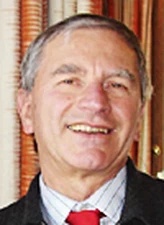Dominique Raynaud

The 2008 Hans Oeschger Medal is awarded to Dominique Raynaud for his key contribution to the reconstruction of past atmospheric composition over the last 800000 years from Antarctic ice cores and to the understanding of the link between greenhouse gases and climate.
Dominique Raynaud has started his scientific career about 40 years ago with a PhD dedicated to the measurement of total air content in ice cores. This parameter influenced by air pressure and thus by the elevation of the ice sheet has now been recognized to be modulated by local insolation and provides one tool to constrain ice core chronologies. Dominique Raynaud has been instrumental in the development of this new tool and he was also involved in studies dealing with the isotopic composition of these air bubbles (15N and 18O) and with the N2/O2 ratio. But his main contribution to ice core studies for which he is fully recognized in our scientific community is the key role he has, along with his LGGE team, played in the reconstruction of past atmospheric composition in carbon dioxyde and methane and to the understanding of the link between these greenhouse gases and climate.
It is in the eighties that studies performed on the Vostok ice in the frame of a collaboration between French and Russian scientists, later extended to US teams, allowed to demonstrate the close correlation between CO2, and later CH4, concentrations in air and Antarctic climate over the last glacial interglacial cycle (the last 150 ka) and to infer that that those greenhouse gases has contributed to glacial-interglacial changes in amplifying the astronomical forcing. These Vostok records were in the nineties extended to four climatic cycles (420 ka) and thanks to the EPICA (European Project for Ice Coring in Antarctica) Dome C ice core and to a close collaboration between the Bern and Grenoble teams these CO2 and CH4 records were recently extended back to 650 ka. They now cover the last 800 ka showing 1) that present-day values has never been observed over this entire period and 2) that the change of pacing observed around 400 kyr BP just before MIS 11 in climate parameters, is also observed for greenhouse gases.
Beyond this key contribution to the reconstruction of the past record of greenhouse gases and its interpretation, which is illustrated by numerous and very well cited publications (more that 30 of them in Science or Nature) Dominique Raynaud and his team have been active in studies dealing with Vostok lake ice, Greenland cores, ice core chronologies and topics dealing with climate sensitivity and biogeochemical cycles.
Publication resulting from this medal
Raynaud, D., Yin, Q., Capron, E., Wu, Z., Parrenin, F., Berger, A., and Lipenkov, V.: Local summer temperature changes over the past 440 ka revealed by the total air content in the Antarctic EPICA Dome C ice core, Clim. Past, 20, 1269–1282, https://doi.org/10.5194/cp-20-1269-2024, 2024.
